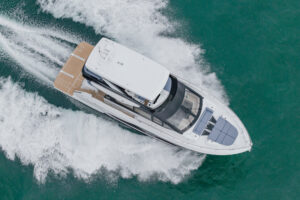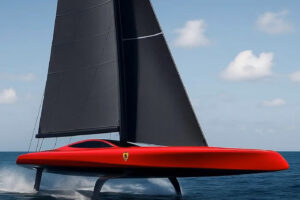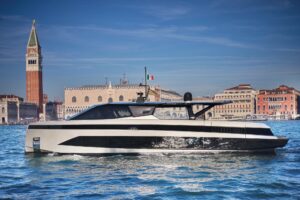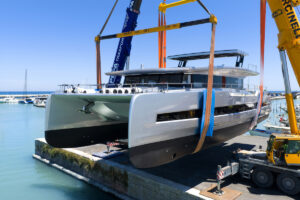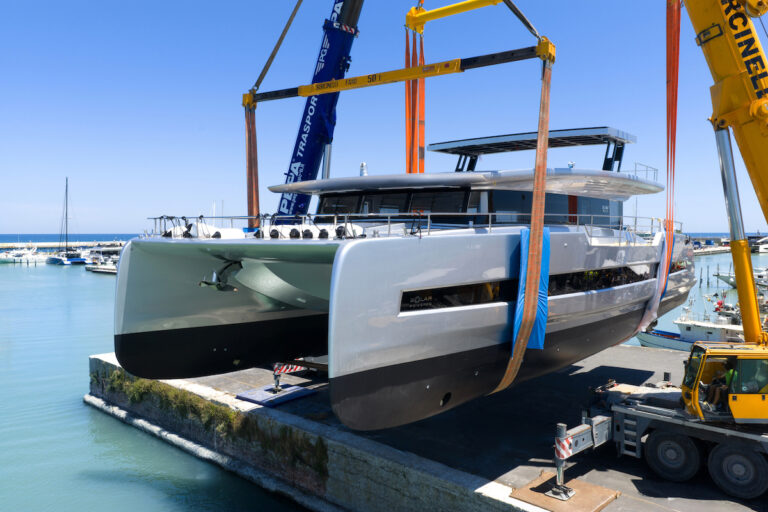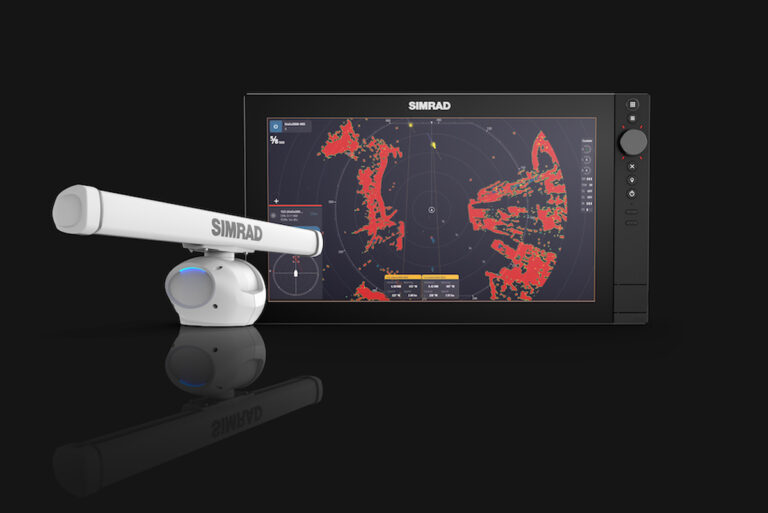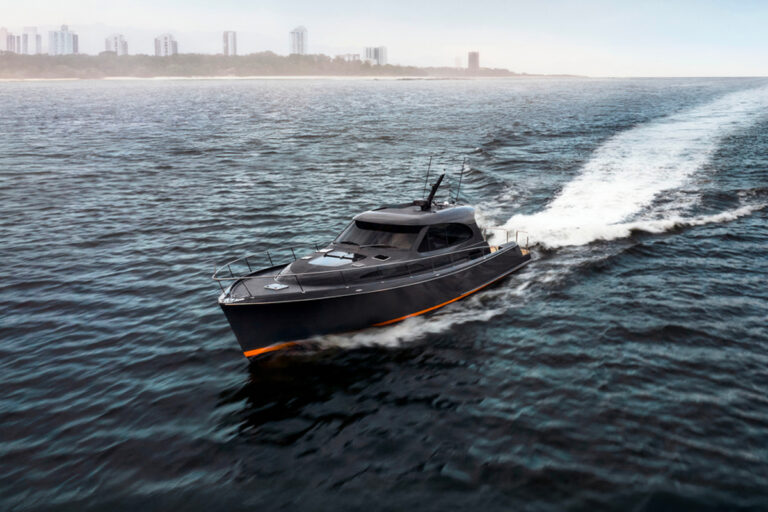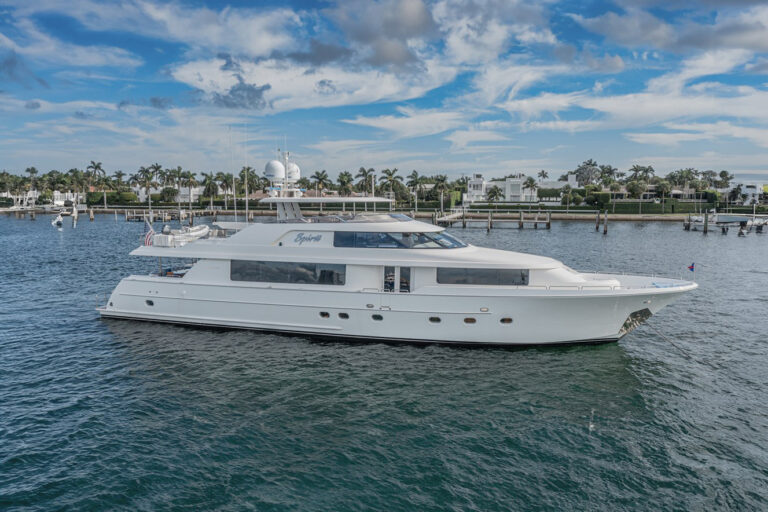Monte Carlo is a magical place. In December, Christmas lights sparkle like stars, and shoppers, chased by a breath of mountain chill, scurry along the narrow sidewalks, dotting the Is and crossing the Ts of their Christmas lists. Mine included the new Wally 78 Carrera, but I had to settle for a sea trial.
Monte Carlo is a perfect location for Wally Yachts. You see, Luca Bassani, head of the company, is an aficionado of stylish and rapid motorcars, and the city has been one of the premier venues of the Formula One circus for about 50 years. Every May, Monte Carlo’s tortuous and narrow streets vibrate with the ear-splitting exhaust of 22 Formula One cars.
A passion for sexy cars gave Carrera her name. The metallic blue paint adorning her topsides recalls the pale silvery blue of the Porsche 993, the factory’s numerical designation for the last of the air-cooled 911 Carreras. Like the 993, Wally’s Carrera is all about going fast in exceptional style.
German Frers did the naval architecture and exterior styling for Carrera, so you know she’s stunning without even looking. Her sheerline appears straight, but if you place a straight edge on the profile, you’ll discover the subtlest of sweeps. When she’s at rest on the mooring, the knuckle at the base of her straight stem stands slightly proud of the water, as though she were a race car all revved up with no place to go.
On paper, straight lines and relatively sharp angles define her trunk cabin, which Frers mercifully kept low. A low profile is far more attractive than a high one, and presents a lot less surface area to breaking seas. The beveled transition from the sheer to the transom and graceful counter add a touch of delicacy to an otherwise seriously aggressive demeanor.
Even in the flesh, Carrera maintains an air of superior strength, purpose and power-less Porsche and more Lamborghini Diablo. The hard edges that establish her character in the drawings soften in their three-dimensional iteration, as though wind and water eroded them. The decks are a desert of teak, slightly cambered to shed solid water quickly. Nothing grows here-no winches, raised hatches, cleats, vents, genoa tracks, pad eyes or other excrescences. Even the headsail’s curved traveler hides in a recess in the foredeck. The look is becoming a trend, as more and more big boats have clutter-free decks, but remember: Wally was first.
All this barren simplicity may intimidate yachtsmen who glean reassurance from seeing a structure’s skeleton, or those who love the look, feel and presence of hardware. “How does it work?” they might ask. Wally B, the first Wally I sailed, intimidated me that way. Carrera did not.
When the Yanmar 4LH auxiliary fired up, the wind barely stirred inside the breakwater at Port Cap D’Ail. Outside, though, were the shifting colors of the wind’s work on the surface-reason to hope for a fine sail.
Carrera doesn’t need much wind. Her rig is large, powerful and efficient, and her canoe body is delightfully short on wetted surface area. She’s an apparent-wind boat, to be sure, because after we got her moving on a close reach, she made the wind that nature failed to give us. The true wind speed never exceeded 11 knots, at least not on the big B&G instruments, but Carrera hummed along at 9.8 to 9.9 knots (a knot short of theoretical hull speed), sailing between 40 and 50 degrees to the apparent wind. This performance wouldn’t be remarkable if we hadn’t taken a reef in the mainsail. As we hoisted the main from the Park Avenue boom, one of the batten cars hung up, ripping a substantial gash a short span below the first reef. The hydraulic halyard winch produces quite a lot of torque and should have a clutch set to disengage the power when the stress exceeds a given limit.
A great tearing of hair and pounding of chest from the crew followed the mishap, but of course, we sailed on. I tacked Carrera eastward while my three companions, still deep in a discussion about the torn sail, settled into comfortable positions in the cockpit. This boat, like other Wallys, is a solo sailor’s dream. Everything you need to drive is within reach of the twin wheels. A pair of massive Harken winches, like sentries, hold station inside the cockpit coaming right forward of each wheel. These mind the halyards and gennaker sheets. Tacking under working sail requires only a turn of the wheel. When you want to jibe, push one mainsheet button to trim in the main as the stern passes through the wind, then the other as you fall off on the new jibe. We didn’t fly the gennaker, which may require a hand or two for the faint of heart. Stalwart sailors will simply engage the autopilot and handle the big sail by themselves.
The vast majority of the rig’s power comes from the North 3DL full-batten main, which sets on carbon spars from Omohundro. Four sets of spreaders sweep aft at more than 20 degrees, eliminating the need for running backstays. The full-beam staying base reduces compression stress on the rig and shoulders some of the responsibility for the absence of runners. A split permanent backstay lets the crew adjust bend in the mast.
Amazingly agile, Carrera felt almost as responsive as a dedicated IMS racing boat. She was quick in stays and accelerated briskly after I hit the groove on the new tack. Her unassisted cable-and-quadrant steering telegraphed the rudder’s every subtle move. Given enough time at the helm, I’m certain I could ignore the instruments and sail by feel alone without sacrificing much speed. She’s exceptionally well balanced, as well. I let go the wheel on a close reach, and she tracked her course like a slot car for more than two minutes.
Our reefed mainsail mocked any attempt at speed off the wind. We simply didn’t have the sail area to move Carrera fast enough on a broad reach to generate her own wind. I saw 5 knots in 8 knots of true wind sailing about 120 degrees to the apparent wind. Lifting the keel didn’t alter the speed.
Carrera is an iteration of the Wally 80 series, which includes Magic Carpet and Genie of the Lamp. Each member of the series shares naval architecture with the others, and the tooling accommodates modest changes in LOA and trunk cabin style. Wally offers a couple of standard in-house arrangements plans and will work with the owner and an interior design specialist for a custom interior. Carrera’s interior was done in a natural-finish teak. It’s no doubt easy to maintain, but the ambience is a bit sterile.
The guest staterooms are separated by a keel box and a bulkhead that spans the space between the box and the mast. Although the arrangements plan sacrifices volume to the keel box, the loss is negligible. Had the fabulous pencil-shape lamps not been affixed to the bulkheads, I would have stolen one.
Wally yachts, in their variety of incarnations, offer good value. A strong and active racing class seems popular with the owners, and the boats place well, compared with other designs of comparable size, in true elapsed time. This activity keeps resale value at a healthy level.
Contact: Wally Yachts, (011) 377 93 1000 93; fax (011) 377 93 1000 94; www.wallyyachts.com.

